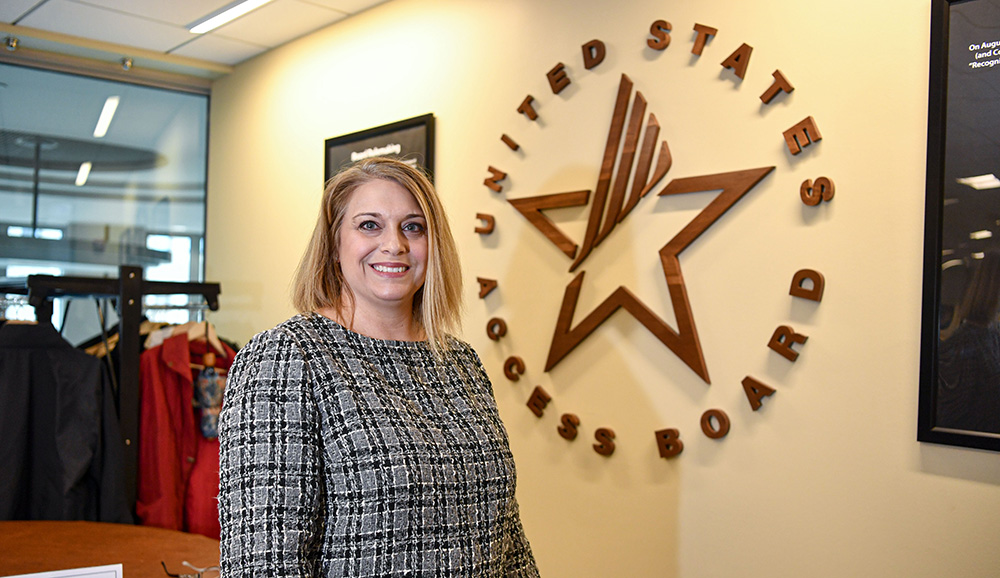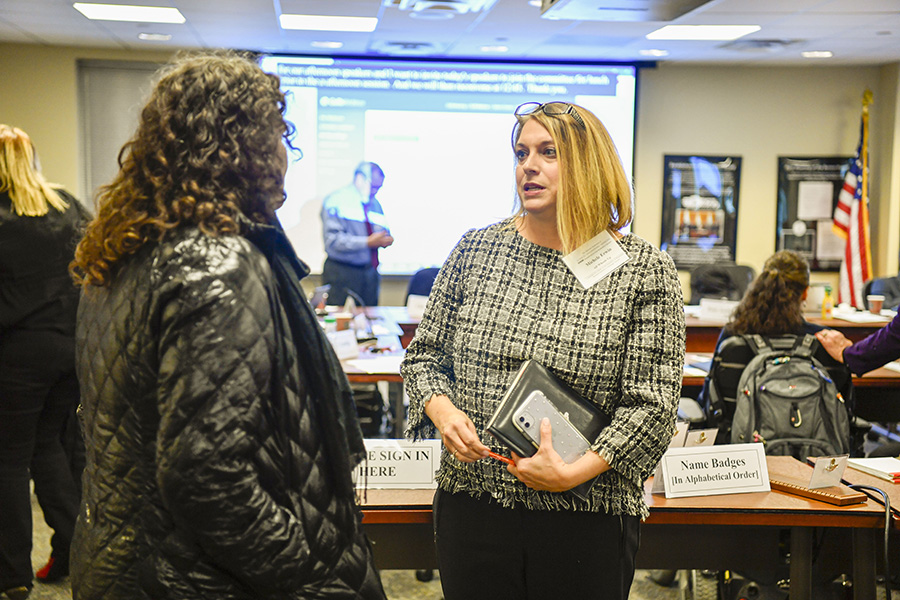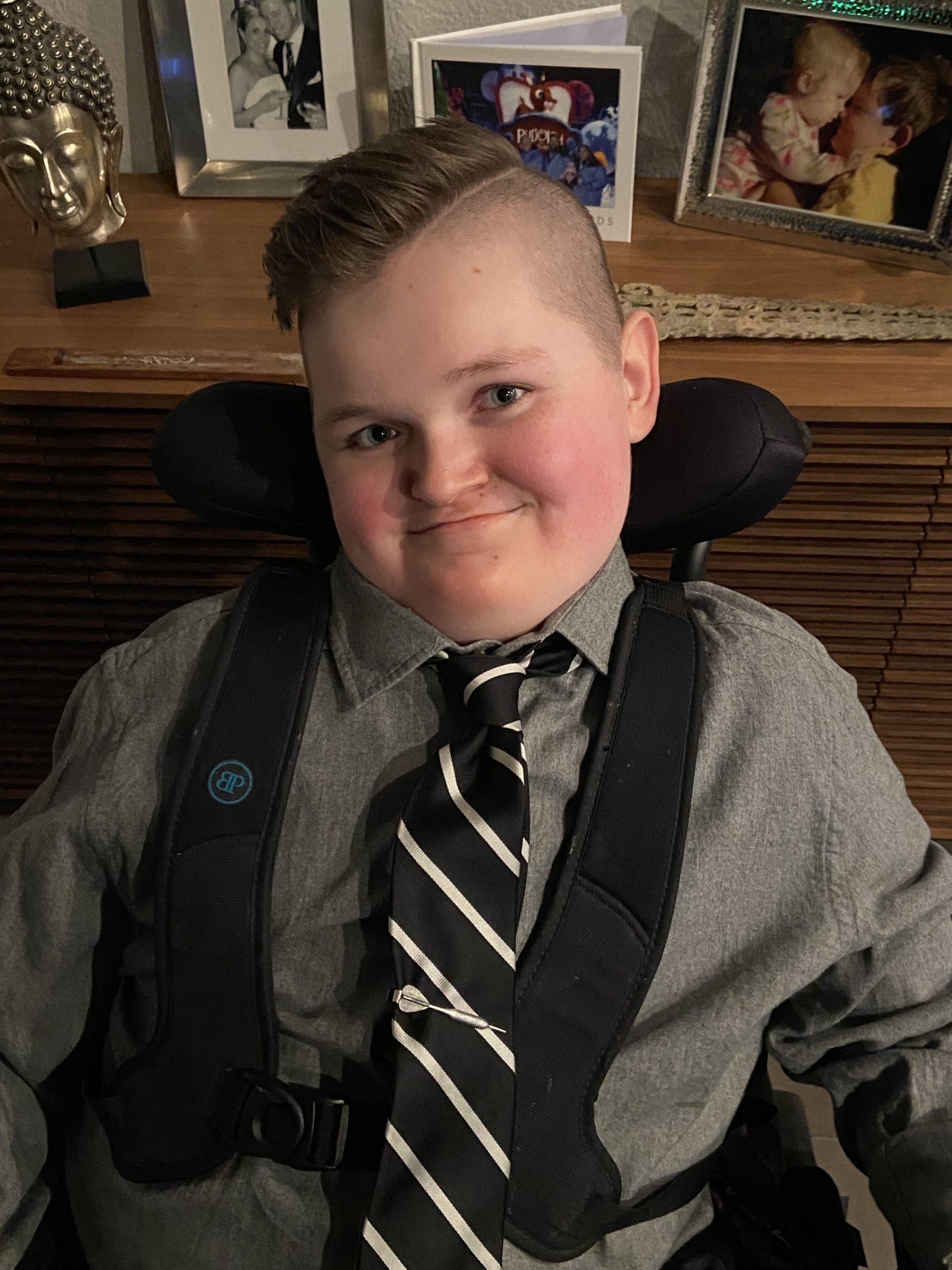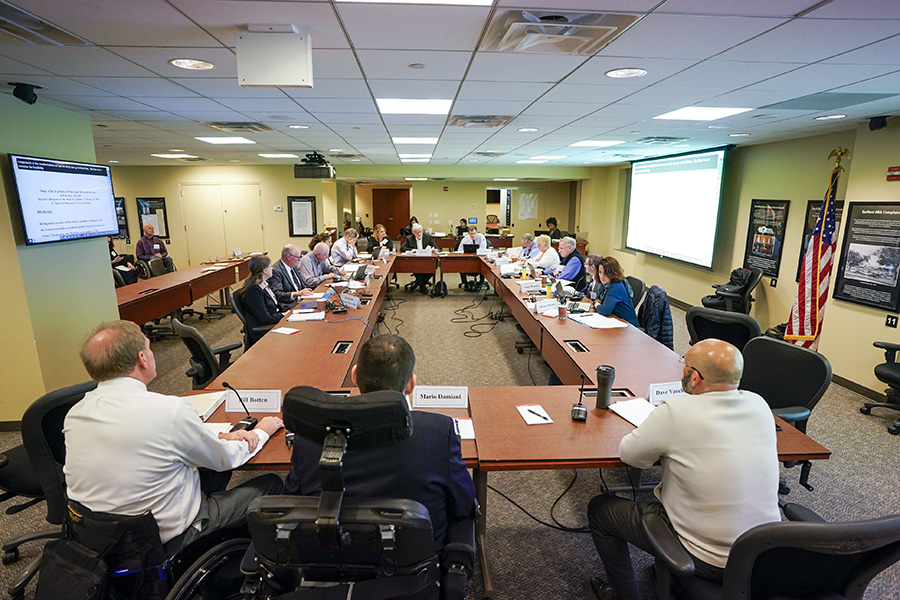Michele Erwin, founder of the volunteer nonprofit All Wheels Up. Jarrad Henderson | USA TODAY
ALL WHEELS UP
Study will review whether its safe to add a designated wheelchair spot on airplanes
When Michele Erwin and her son with spinal muscular atrophy flew to Disney World in 2011, she had to disassemble his electric wheelchair on the jetway so that it could be stored in the cargo hold.
As she took apart the medical device that Greyson lived in, she wondered, “Why can’t he roll onto the plane and strap down his chair just as we do on buses, trains and the family minivan?”
Then Erwin asked a better question: What can I do to make that a reality?
“I wasn’t looking to reinvent the wheel,” she said. “So I started researching if any organization was already doing this and at that time there wasn’t any organization who is even advocating a wheelchair spot on an airplane.”
A few months after the family trip to Disney, Erwin founded the volunteer nonprofit All Wheels Up. The small group raised thousands of dollars to pay for the first crash tests to see if a wheelchair locked to the floor could survive plane-crash forces. (It could.)
After Erwin got the attention of Capitol Hill and backing from established disability rights organizations, Congress ordered the U.S. Access Board to study the feasibility of a wheelchair restraint system for planes and to discuss technical standards.
Michele Erwin (right) talks with an accessibility manager for JetBlue Airlines at the kick-off meeting of a federal study on the feasibility of a wheelchair spot on passenger airplanes. Jarrad Henderson | USA TODAY
That group of experts met for the first time on Wednesday in a Washington, D.C. conference room. Among federal regulators, aircraft engineers, wheelchair manufacturers and disability advocates, sat Erwin, a fashion sourcing manager for JCPenney who had previously worked for Ralph Lauren and Calvin Klein.
“I am the least likely person to be an advocate for a wheelchair spot on an airplane,” she said.
For decades, travelers and policy advocates had dreamed that people might one day be able to roll onto planes and fly from the comfort of their own mobility devices. But other accessibility battles dominated their work: damage to wheelchairs, tiny lavatories, and service animal rules, among other issues.
Erwin’s single-minded focus on creating a designated wheelchair spot on airplanes helped bring together key players from industry and civil rights organizations to discuss the idea seriously and in practical terms.
“Honestly, I don’t think we would’ve gotten in the same room without Michele,” said Brad Meier, a product manager for Quantum Rehab and Pride Mobility.
Afraid to fly
Erwin said the most difficult part of convincing people that wheelchair users should be able to fly from their own seats has not been testing crash safety, pitching members of Congress or engineering a restraint system.
It’s been getting people to see the hardships wheelchair travelers face.
“When I talk about wheelchairs on airplanes I know what I’m talking about because I have a child in a wheelchair and I know what a wheelchair spot is in a bus or a minivan or train,” she said. “Somebody who is not in the disability community won’t even realize that a plane doesn’t have a wheelchair spot.”
As a result, flying is “a nightmare” for wheelchair users and that means 50 percent of chair users miss out on work opportunities or leisure travel because they avoid flying altogether, according to an All Wheels Up survey.
Lee Page, senior associate advocacy director for Paralyzed Veterans of America, walked members of the study committee through the process on Wednesday.
After rolling to the end of the jet bridge, chair users must transfer out of their own device into a aisle-chair owned by airlines and designed to navigate the narrow aisles. Some people have enough strength to transfer themselves but others must be lifted by airline contractors, who have little to no training on how to do so. They then are wheeled backward down the aisle to their assigned seat and again lifted into place by staff.
“FAA standards set a minimum aisle width of 15 inches,” Page said. “My backside is 18 inches by 19 inches. I’m hitting every armrest on the way back.”
It’s a process wheelchair users and their families say is embarrassing, and injuries are common. Airlines have paid millions of dollars when sued after people have been dropped or fell out of the chairs. Even when things go well, people with spinal injuries or sensitive skin might experience injuries from the kinds of bumps and bruises that able-bodied passengers would shrug off.
Rory Cooper, a member of the study committee who also is a professor of rehabilitation engineering at the University of Pittsburgh, summed it up: “Currently, the system does put people at risk.”
For example, Erwin said her son, now 13 years old, can’t fly anymore because he has developed brittle bone disease. The Make-A-Wish Foundation has offered the family a trip to Japan, but Erwin isn’t sure how Greyson could do it.
Greyson Erwin, 13, has brittle bone disease that makes it too dangerous for him to fly in a plane’s regular passenger seat. [Family photo]
“The airlines have been great to work with. We just can’t figure out how to make it safe,” she said. “If his hip breaks again, it would lead to amputation.”
She hopes to come up with an alternative adventure that would still tap into his love for sushi and anime — one that won’t involve flying.
Erwin’s solution
All Wheels Up has proposed that airplanes of the future include a passenger seat that can be unlocked from the floor and folded up to make room for a traveler to park their chair. That way airlines can always sell a ticket to someone in that space.
A tie-down or locking pin system could then anchor the person’s wheelchair for the flight.
Collecting “$25 at a time” from Facebook donors, All Wheels Up Vice President Alan Chaulet said the nonprofit raised $10,000 for an initial safety test of prototype restraint systems. In 2016 and in 2019, Calspan, a respected research laboratory, strapped dummies into surrogate wheelchairs and then Pride Mobility power chairs, attached them to a sled and slung them down tracks at high speeds. One test simulated a taxiing accident and another a crash landing.
“The chair is unable to be driven or function as intended after each one of these tests. But it does keep the system together and it does keep the occupant in the chair as well,” Meier said. “Technically they all passed (the FAA crash-force standards), but there was room for improvement.”
Erwin said most of the chairs actually were still drivable.
She said the tests proved that a restraint system could be safe, although everyone involved in the testing cautioned more research needs to be done to understand the best type of tie-down system and which kinds of chairs are air-worthy. She noted that airline operators and manufacturers — including Airlines for America, the industry association representing all major passenger airlines — have started to join All Wheels Up working groups to brainstorm next steps.
“You have to have balance and compromise,” said airline accessibility consultant Chris Wood from Flying Disabled. “Safety is not one of them.”
John Sheldon, a passenger seat expert from the Federal Aviation Administration, said he was confident that airline manufacturers could design a safe system. He also noted that the FAA would be open to waiving some crash-test standards because improving travel for people with disabilities would “clearly” be in the public interest.
“We have a good record of finding a way to get it approved,” he told the committee.
Not-so-simple solution
For many people with chairs, adding a restraint system on planes seems like an elegant solution.
It would end the need to have crew members lift travelers from wheelchair to aisle chair to seat and would keep precious mobility devices on the plane instead of risking damage in the cargo hold. A designated wheelchair spot would keep travelers in the chairs designed to meet their medical needs, reducing the risks of injury that many endure when they fly today.
Erwin is the first to admit, however, that the actual task of redefining air travel for chair users is “very complex and multifaceted.”
“To get to true feasibility and certification, we need more funding. … We are talking in the millions of dollars,” Erwin said.
Airplane interiors might have to change to make room for wheelchairs. Chair and restraint manufacturers might need the FAA to set safety and design standards. Plane evacuation plans would have to be updated. Airlines would have to develop new boarding procedures and retrain thousands of employees. And those are just a few of the practical challenges.
“Any organization that says this can happen in two years is misleading the wheelchair community,” she said. “You cannot put a timeline on a project of this magnitude.”
Yet, less than a decade after that trip to Disney World, Erwin sees a path to better air travel for her son and millions of other people who use power chairs and wheelchairs.
An expert panel organized by the U.S. Access Board and the National Transportation Research Board meets on the possibility of including wheelchairs on commercial flights in Washington, D.C. on Wednesday, Feb. 5, 2020. Jarrad Henderson | USA TODAY



